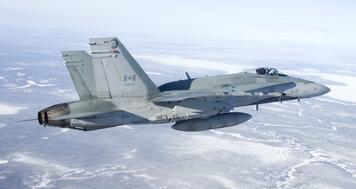Fighter Aircraft (1): Threats and Priorities

See The Simons Foundation's Disarming Arctic Security page for briefing papers on military policies and practices in the Arctic region by Ernie Regehr, Senior Fellow in Arctic Security at The Simons Foundation.
Fighter Aircraft (1): Threats and Priorities
May 29, 2015
The current deployment of Canadian fighter aircraft for bombing attacks in Iraq and Syria, along with the resurgence of “air power diplomacy” from the Black Sea to the Arctic Ocean, should refocus attention on the Ottawa melodrama known as the CF-18 fighter replacement program. The dénouement was once again put off when Ottawa announced refurbishments intended to keep the CF-18s flying to 2025; it’s a useful delay that furnishes more time for debating the options, including those that some find unpalatable.
The Conference of Defence Associates Institute’s recent Vimy Paper on “The Strategic Outlook for Canada” acknowledges in barely disguised alarm that the debate over the CF-18 replacement has “even provoked a discussion on whether a country like Canada, the second largest in the world, actually need[s] a fighter aircraft.” The paper is sub-titled “the eclipse of reason,” a general reference to the apparent flight of reason in conflicts from the Ukraine to the Middle East, but the paper also makes it clear that any notion that Canada might not need or acquire fighter aircraft fits squarely into the CDA Institute’s definition of the irrational. That they bring it up at all is no doubt linked to the unusual source of the suggestion. A former, and formerly very prominent, Deputy Minister of National Defence, Charles Nixon, penned an op-ed for the Globe and Mail last summer in which he said plainly, and without qualification, that Canada does not need fighter aircraft. “Fighters,” he said, “simply cannot contribute anything substantial toward the achievement of the six Canadian defence objectives” (see below). It’s a proposition that at least one episode in the CF-18 replacement drama should seriously consider.
The Government’s current plan is to acquire 65 new fighter aircraft, with any firm decision now delayed until well after the election. They are to replace the 77 CF-18s still in operation, out of the 138 purchased in the 1980s. The most recent cost estimate for acquiring 65 F-35 aircraft and operating the fleet for 30 years is $45.8 billion – that amounts to $2 million per month per aircraft (or $130 million per month or $1.5 billion per year for the whole fleet). The capital portion of that cost (which includes the aircraft plus initial spares and ammunition), has been frozen at $9 billion by the Government, which implies that if the price per aircraft were to go up, the number of aircraft to be purchased would decline accordingly. And there is little doubt that costs will rise. A new report from the US Government Accountability Office (GAO) says that because the Pentagon has begun production of the aircraft (more than 100 have now been delivered) while still deeply involved in developmental testing, important design changes continue to be made. And all of these changes require costly retrofits to completed aircraft. The GAO raises doubts whether even the Pentagon will be able to afford all the aircraft it had planned to acquire.
Canada has already had to reduce the number planned from 80 aircraft to 65 over funding restraints. So the number could still go lower, which in turn implies that the number of aircraft to be acquired is driven, not so much by a careful assessment of need, as by an arbitrarily set acquisition budget. Affordability is certainly not irrelevant, but neither is a clear understanding of what is actually required, and why – based on security considerations. Continue reading...
Ernie Regehr, O.C. is Senior Fellow in Arctic Security at The Simons Foundation, and Research Fellow at the Institute of Peace and Conflict Studies, Conrad Grebel University College, University of Waterloo.